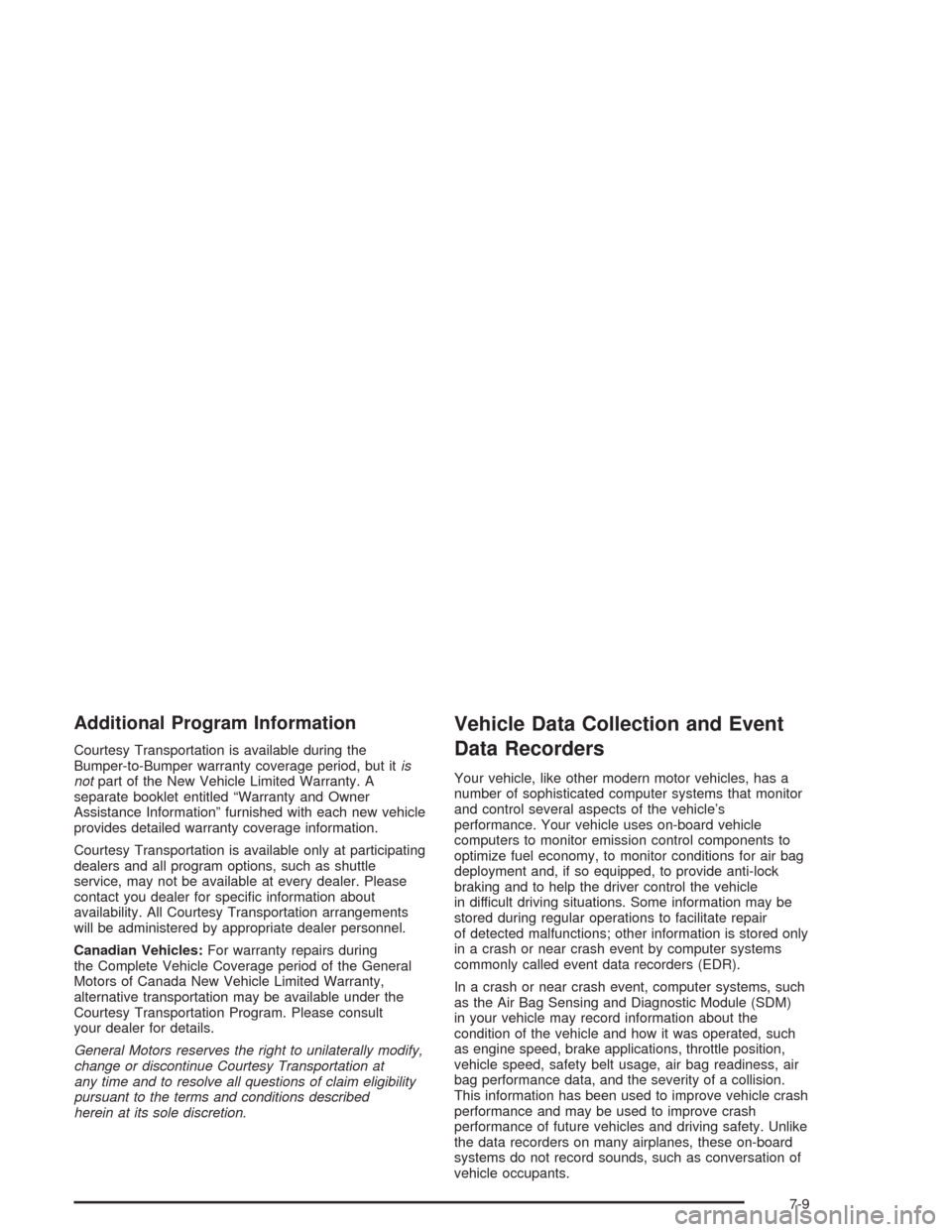2004 CHEVROLET TAHOE lane assist
[x] Cancel search: lane assistPage 351 of 556

If you drive regularly in steep country, or if you are
planning to visit there, here are some tips that can make
your trips safer and more enjoyable. SeeOff-Road
Driving on page 4-23for information about driving
off-road.
Keep your vehicle in good shape. Check all �uid
levels and also the brakes, tires, cooling system
and transmission. These parts can work hard
on mountain roads.
Know how to go down hills. The most important
thing to know is this: let your engine do some of
the slowing down. Shift to a lower gear when you go
down a steep or long hill.
{CAUTION:
If you do not shift down, your brakes could get
so hot that they would not work well. You
would then have poor braking or even none
going down a hill. You could crash. Shift down
to let your engine assist your brakes on a
steep downhill slope.
{CAUTION:
Coasting downhill in NEUTRAL (N) or with the
ignition off is dangerous. Your brakes will have
to do all the work of slowing down. They could
get so hot that they would not work well. You
would then have poor braking or even none
going down a hill. You could crash. Always
have your engine running and your vehicle in
gear when you go downhill.
Know how to go uphill. You may want to shift down to
a lower gear. The lower gears help cool your engine
and transmission, and you can climb the hill better.
Stay in your own lane when driving on two-lane
roads in hills or mountains. Do not swing wide
or cut across the center of the road. Drive at speeds
that let you stay in your own lane.
As you go over the top of a hill, be alert. There
could be something in your lane, like a stalled car or
an accident.
You may see highway signs on mountains that
warn of special problems. Examples are long
grades, passing or no-passing zones, a falling rocks
area or winding roads. Be alert to these and take
appropriate action.
4-47
Page 535 of 556

Additional Program Information
Courtesy Transportation is available during the
Bumper-to-Bumper warranty coverage period, but itis
notpart of the New Vehicle Limited Warranty. A
separate booklet entitled “Warranty and Owner
Assistance Information” furnished with each new vehicle
provides detailed warranty coverage information.
Courtesy Transportation is available only at participating
dealers and all program options, such as shuttle
service, may not be available at every dealer. Please
contact you dealer for speci�c information about
availability. All Courtesy Transportation arrangements
will be administered by appropriate dealer personnel.
Canadian Vehicles:For warranty repairs during
the Complete Vehicle Coverage period of the General
Motors of Canada New Vehicle Limited Warranty,
alternative transportation may be available under the
Courtesy Transportation Program. Please consult
your dealer for details.
General Motors reserves the right to unilaterally modify,
change or discontinue Courtesy Transportation at
any time and to resolve all questions of claim eligibility
pursuant to the terms and conditions described
herein at its sole discretion.
Vehicle Data Collection and Event
Data Recorders
Your vehicle, like other modern motor vehicles, has a
number of sophisticated computer systems that monitor
and control several aspects of the vehicle’s
performance. Your vehicle uses on-board vehicle
computers to monitor emission control components to
optimize fuel economy, to monitor conditions for air bag
deployment and, if so equipped, to provide anti-lock
braking and to help the driver control the vehicle
in difficult driving situations. Some information may be
stored during regular operations to facilitate repair
of detected malfunctions; other information is stored only
in a crash or near crash event by computer systems
commonly called event data recorders (EDR).
In a crash or near crash event, computer systems, such
as the Air Bag Sensing and Diagnostic Module (SDM)
in your vehicle may record information about the
condition of the vehicle and how it was operated, such
as engine speed, brake applications, throttle position,
vehicle speed, safety belt usage, air bag readiness, air
bag performance data, and the severity of a collision.
This information has been used to improve vehicle crash
performance and may be used to improve crash
performance of future vehicles and driving safety. Unlike
the data recorders on many airplanes, these on-board
systems do not record sounds, such as conversation of
vehicle occupants.
7-9
Page 554 of 556

Tires (cont.)
Changing a Flat Tire....................................5-80
If a Tire Goes Flat.......................................5-80
In�ation - Tire Pressure................................5-69
Inspection and Rotation................................5-72
Pressure Monitor System..............................5-70
Spare Tire................................................5-100
Uniform Tire Quality Grading.........................5-76
Wheel Alignment and Tire Balance.................5-77
Wheel Replacement.....................................5-77
When It Is Time for New Tires......................5-74
To Use the Engine Coolant Heater....................2-25
Top Strap......................................................1-58
Top Strap Anchor Location...............................1-59
Torque Lock...................................................2-41
Total Weight on Your Vehicle’s Tires..................4-72
Tow/Haul Mode...............................................2-29
Tow/Haul Mode Light.......................................3-54
Towing
Recreational Vehicle.....................................4-55
Towing a Trailer..........................................4-65
Your Vehicle...............................................4-55
Traction
Assist System (TAS)...................................... 4-9
Off Light.....................................................3-46
Stabilitrak
®System......................................4-12
TRACTION ACTIVE........................................3-75
Traction Control Operation................................4-13
TRACTION SYS LIMITED................................3-75Trailer
Recommendations.......................................4-65
Trailer Brakes.................................................4-73
Trailer Wiring Harness.....................................4-78
Transfer Case........................................5-50, 5-52
Transmission
Fluid, Automatic...........................................5-24
Temperature Gage.......................................3-48
TRANSMISSION HOT.....................................3-75
Transmission Operation, Automatic....................2-26
Transmission, Transaxle, Transfer Case Unit
Repair Manual............................................7-11
Transportation Options...................................... 7-8
Traveling to Remote Areas...............................4-27
Trip Information Button....................................3-57
Trip Odometer................................................3-41
Turn and Lane Change Signals.......................... 3-8
TURN SIGNAL ON.........................................3-76
Turn Signal/Multifunction Lever........................... 3-7
Turn Signals When Towing a Trailer..................4-75
U
Underhood Fuse Block...................................5-113
Understanding Radio Reception.......................3-137
Uniform Tire Quality Grading............................5-76
United States – Customer Assistance.................. 7-4
Used Replacement Wheels..............................5-78
Using Cleaner on Fabric................................5-101
16